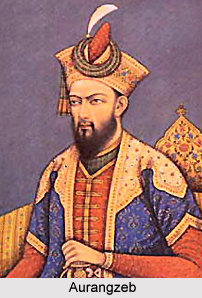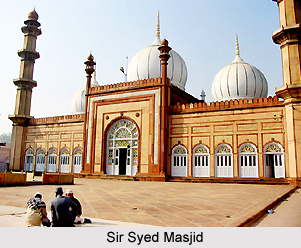 Aligarh is a large and important city of the state of Uttar Pradesh in northern India. It is located at a distance 90 miles south-east of New Delhi. This city is more popularly known as a university town. Here the well renowned Aligarh Muslim University is situated. Aligarh embraces the ancient settlement of Koil. Before the first Muslim invasion, the town was renowned for the stronghold of the Rajputs. The great minaret founded by Ghiyath-ud-Din Balban in 1252 was destroyed in the year 1862. Between the years 1401 and 1440 Koil remained a strategic stronghold in the disagreement between the forces of Ibrahim Sharqi of Jaunpur and the Delhi military forces. After the death of Aurangzeb and with the collapse of Mughal authority, Koil was contested by the Jats, Marathas, Rohilla and Afghans. In the year 1784, Scindia seized control and it remained in Maratha hands until the year 1803, with the exception of a brief interregnum during which a Rohilla garrison was placed here. During the Mutiny the local soldier`s rebelled and British control was not reemployed until 5 October 1857.
Aligarh is a large and important city of the state of Uttar Pradesh in northern India. It is located at a distance 90 miles south-east of New Delhi. This city is more popularly known as a university town. Here the well renowned Aligarh Muslim University is situated. Aligarh embraces the ancient settlement of Koil. Before the first Muslim invasion, the town was renowned for the stronghold of the Rajputs. The great minaret founded by Ghiyath-ud-Din Balban in 1252 was destroyed in the year 1862. Between the years 1401 and 1440 Koil remained a strategic stronghold in the disagreement between the forces of Ibrahim Sharqi of Jaunpur and the Delhi military forces. After the death of Aurangzeb and with the collapse of Mughal authority, Koil was contested by the Jats, Marathas, Rohilla and Afghans. In the year 1784, Scindia seized control and it remained in Maratha hands until the year 1803, with the exception of a brief interregnum during which a Rohilla garrison was placed here. During the Mutiny the local soldier`s rebelled and British control was not reemployed until 5 October 1857.
There are two major landmarks or monuments in Aligarh. The first one is `Aligarh Fort` and another one is `Sir Syed Masjid` in the campus of Aligarh Muslim University. There is another old fort in this city and that is the `Dor fortress` (1524). Aligarh also comprises various tombs of renowned Muslim saints. Jainism Teerth Dhaam called the `Mangalayatan Teerth Dhaam` has been built at the city`s Agra Road. There is an extremely beautiful Jain Temple which is believed to be almost 200 years old. It has Fresco Painted Ceilings. The Aligarh Fort was constructed during the reign of Ibrahim Lodi in the year 1524. It was strengthened subsequently by French engineers and later, by the British. The main entrance to this fort is from the north direction. Perron`s House or the Sahib Bagh, which is now the University Medical Institution is at a distance of 800 m to the south of the Aligarh Fort. Approached through a square entrance arch with a guardroom over, the garden compound has a well with a dedication in Persian. Moreover, there is an old cemetery close to the Fort.
 Situated at the crown of a long and steep slope is the Bala Kila, a principal mosque. It was built in the year 1728 by Sabit Khan and that too on the site of earlier Hindu and Buddhist temples. To its south-east is the `Moti Masjid` or the `Pearl Mosque` (17th century). The Civil Station lies to the northeast of the city. It embraces the old cantonment that was eradicated in the year 1869. It was laid out on classic colonial lines of structure that follow a simple grid pattern. Some more principal buildings of interest of Aligarh are mainly concentrated along Anupshahr Road: the Judges` Court, District School, jail and cemetery. Opposite the Judges` Court there is an avenue that links Crosthwaite Hall with the Harrison Clocktower (late 19th century). The Lyall Library was established in the year 1889. This distinguished building depicts Indo-Saracenic style. Aligarh Muslim University, formerly known as the Anglo-Oriental College, is a renowned international centre of Muslim education and theology. It was established by Sir Saiyad Ahmad Khan and laid out in the manner of the Oxford and Cambridge colleges amidst beautiful landscaped gardens.
Situated at the crown of a long and steep slope is the Bala Kila, a principal mosque. It was built in the year 1728 by Sabit Khan and that too on the site of earlier Hindu and Buddhist temples. To its south-east is the `Moti Masjid` or the `Pearl Mosque` (17th century). The Civil Station lies to the northeast of the city. It embraces the old cantonment that was eradicated in the year 1869. It was laid out on classic colonial lines of structure that follow a simple grid pattern. Some more principal buildings of interest of Aligarh are mainly concentrated along Anupshahr Road: the Judges` Court, District School, jail and cemetery. Opposite the Judges` Court there is an avenue that links Crosthwaite Hall with the Harrison Clocktower (late 19th century). The Lyall Library was established in the year 1889. This distinguished building depicts Indo-Saracenic style. Aligarh Muslim University, formerly known as the Anglo-Oriental College, is a renowned international centre of Muslim education and theology. It was established by Sir Saiyad Ahmad Khan and laid out in the manner of the Oxford and Cambridge colleges amidst beautiful landscaped gardens.
Monuments of Aligarh narrate the story of this city associated with its past. These monuments also reflect the lavish architectural patterns inspired by the Mughal era.



















